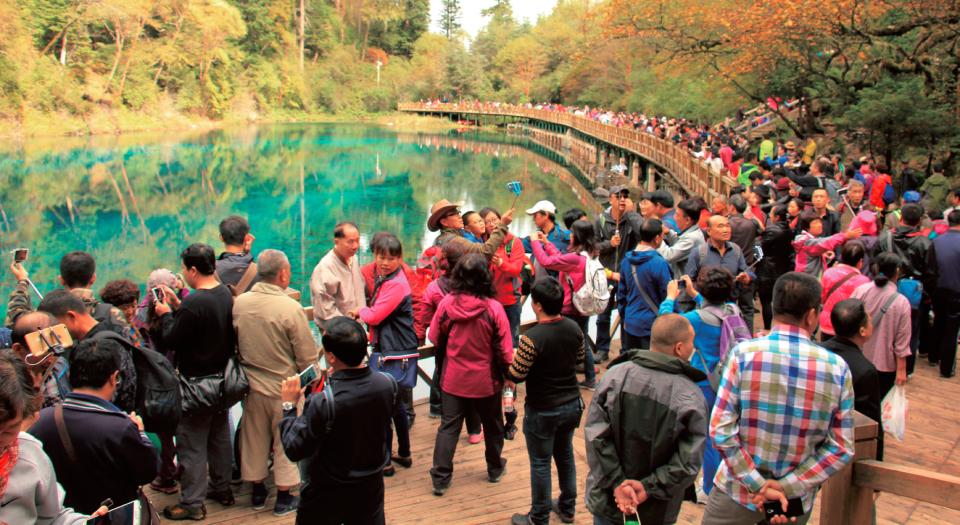China aims to establish a new national park system by late 2017. The first step is already in motion – nine protected areas from across the country are in the process of transforming into the country’s first group of national parks. To help China move forward with this mammoth task, the National Development and Reform Commission has appointed nine conservation experts to act as an advisory body throughout the course of this project. Zhu Chunquan brings nearly three decades of experience to the team. He currently serves as the country representative for the China office of the International Union for Conservation of Nature (IUCN), and was previously the conservation director of the World Wide Fund for Nature’s China branch from 2005-2012. As part of the expert team, he has helped evaluate all nine of the pilot national parks’ initial plans.
This initiative has not been without controversy. Some stakeholders – mainly local governments that rely on strong tourism numbers to prop up the local economy – think that economic development within the parks should take priority over conservation. But Zhu said that after a few years of negotiations and discussions, opposing parties are finding more common ground. China’s national parks will be protected areas that aim to safeguard the diverse species and integrated ecosystems within their borders. “Despite some differing opinions over minor aspects, the overall understanding of the concept [of national parks] is rather clear and meets international standards,” Zhu said.
NewsChina met with Zhu in the IUCN China office in eastern Beijing to talk about the future of China’s national park system and conservation as a whole.
NewsChina: From an international perspective, what is the current state of China’s existing protected areas?
Zhu Chunquan: This year marks the 60th anniversary of the founding of China’s first nature reserve, the Dinghu Mountain National Nature Reserve, which was established in 1956. Generally speaking, China’s protected areas have made significant strides. They cover over 18 percent of China’s terrestrial and inland water areas, and the State Forestry Administration pledged that number will reach 22 percent by 2020. Both of these figures are much higher than the world average.
China’s protected areas are very valuable. If you measure by either number of species or types of ecosystems, China is a key region that enjoys high levels of biodiversity. For example, China boasts more than 34,000 higher plant species, half of which are endemic to China, and over 6,000 vertebrate species.
There are more than 10,000 protected areas in China, but they are not evenly distributed. Protected areas cover one million square kilometers in western China’s Qinghai-Tibet plateau region, accounting for almost 10 percent of China’s total land area. By contrast, in the eastern coastal areas that are heavily industrialized, protected areas are limited in both number and size.
From another perspective, the effectiveness of management in different protected areas varies significantly as well. Many protected areas do not operate independently, nor do they have specially trained staff or sufficient funding. For example, some personnel in protected areas are former loggers who previously worked for State-owned timber suppliers. They are not qualified to conduct conservation projects or even go on daily patrols.
NC: How will the new national park system impact the management of other protected areas in China?
ZC: The biggest problem affecting the management of China’s protected areas is their lack of an integrated scientific system. Various government departments have introduced different types of protected areas at different times since 1956. The Jiuzhaigou nature reserve in Sichuan Province is an extreme case [of what can happen as a result].
Although it is a nature reserve, Jiuzhaigou also has a ‘scenic spot,’ ‘forest park,’ and ‘geopark’ all within its borders, creating a chaotic situation.
First, it makes the target of protection ambiguous. Is it animal species, ecosystems, natural scenery or geoheritage? Second, having so many types of protected areas in one spot means all of those corresponding departments administrate that site. This makes management very confusing.
To combat such situations and to simplify the protected area system, the IUCN has been trying to standardize protected area categorization since the early 1960s.
China’s exploration of a new national park system is an opportunity to straighten out the various types of protected areas, and I hope it will refer to the IUCN categorization method when doing so. It would be beneficial for stakeholders from different sectors – government officials, business leaders, community members and representatives of international organizations like the UN – to all actively participate in conservation efforts. But it is also important to have unified standards and an effective management system that includes a working mechanism, adequate funding, daily supervision, community participation and the participation of international or domestic NGOs. National parks are just one kind of protected area, and not all current nature reserves will turn into national parks.
There are a few ways to go about establishing national parks in China. One is to turn some appropriate nature reserves directly into national parks. For example, protected areas like Changbaishan, Huangshan and Zhangjiajie all meet the standards of being in need of conservation and having gorgeous views. The other option is to integrate adjoining nature reserves into one large national park. For example, the area surrounding Sichuan Province’s Min Mountains, one of the giant panda’s main habitats which includes the protected areas of Wanglang, Jiuzhaigou and Huanglong, could become one single national park. The national park system should break the binds of administrative division, even between provinces, if necessary.
NC: What features of a Chinese national park system will make it different from those of other countries?
ZC: A national park in China should have the following five characteristics: first and foremost, it is composed of a large area that contains intact ecosystems; second, it has rich biodiversity, geodiversity, spectacular scenic views and outstanding cultural value; third, it is beneficial to the general public; fourth, it symbolizes China’s unique beauty and the country as a whole; fifth, it evinces Chinese people’s national identity and national pride.
Forming China’s national park system requires the sufficient study of models from other countries, yet we cannot simply copy from those that already exist. The reality is that almost all of the protected areas in China currently experience some sort of intrusive human activity both inside the protected zone and in its surrounding area, unlike similar areas in the US and Australia. The IUCN has advocated for balancing conservation and development [to counter this], and has focused its efforts on local community development. In order to effectively protect flagship [or iconic] species like the Siberian tiger and the giant panda, the only effective way is to help locals find alternate livelihoods that reduce their dependence on natural resources so that they no longer damage these animals’ habitats. There are already quite a few successful cases of community development projects in China that focus on nature conservation.
NC: How can China become a leader in biodiversity conservation and the development of an ‘ecological civilization’?
ZC: China has accomplished some significant achievements; for example it has made great progress in protecting some flagship species, such as the giant panda, Tibetan antelope and Asian crested ibis.
Over the past three decades, China has learned a lot in the field of conservation biology from the many foreign experts who have come to China for research and the implementation of conservation programs.
China has made many successful and unsuccessful attempts in its nature conservation efforts. If Chinese researchers were to compile these case studies into a manual to which other developing countries could refer, it would be very meaningful.
One major problem is that, despite China’s rapid development, the old mentality that domestic organizations must seek foreign funding remains. Experts from the developed world, like George Schaller and John MacKinnon, come to China and stay in local communities to conduct their projects, but Chinese conservation experts rarely travel to other countries for theirs. It is time for China and Chinese conservationists to change this outdated mentality, travel internationally and introduce themselves to the outside world.

 Old Version
Old Version
